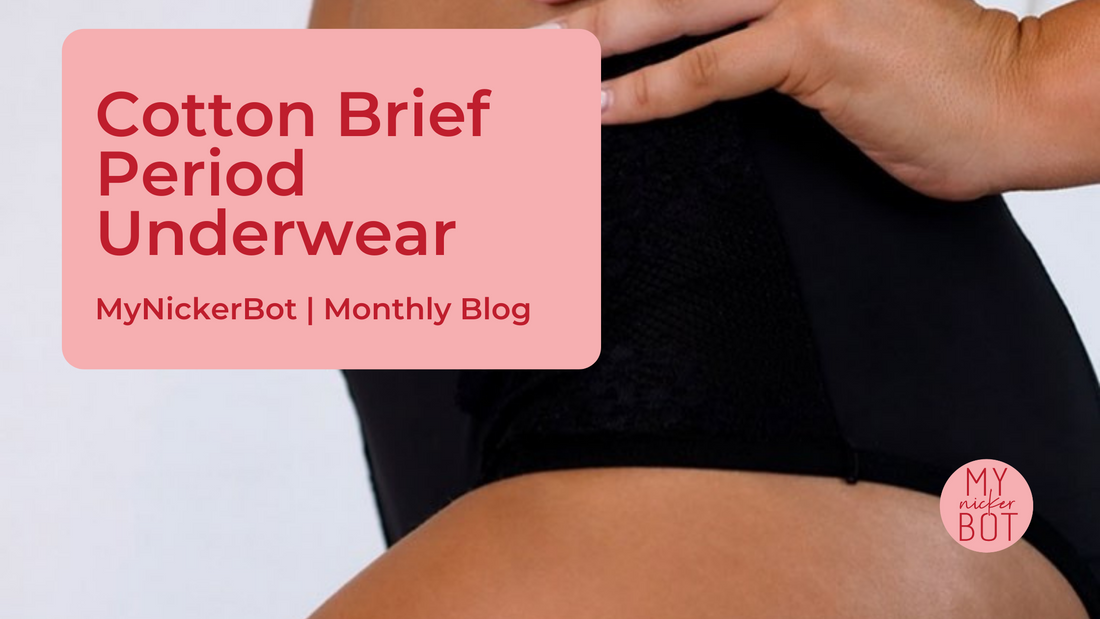
Cotton Brief Period Underwear: Everything You Need to Know
Share
Previously a niche that only women with money to spare can afford, period underwear are now readily available. Startups and entrepreneurs keen on capturing a slice of the lucrative global menstrual market are disrupting the period wear industry with period underwear.
Tampon manufacturers used to dominate the market, often marketing their products in a shame-based, stigmatised manner. This led to girls and women signing up to purchase tampons and menstrual cups via online delivery services.
There are several reasons why women are turning away from single-use pads and tampons. In part, the explosive growth of period underwear derives from a growing knowledge of the potentially disastrous environmental impact of single-use menstrual products.
What is Cotton Brief Period Underwear?

Period underwear is exactly what it sounds like. They are panties worn during your period. In addition to being absorbent like a pad and leak-proof, they also offer odour control and allow you to avoid not only buying feminine hygiene products but also adding them to the landfill.
No matter what brand you choose, period underwear always has the same basic design: a cotton or polycotton blend, with an ultra-high-absorbency fabric sewn into the gusset. By simply rinsing out the knicker in cold water, and then putting them in the washing machine with a regular load of laundry, users are able to clean their knickers easily.
Period underwear have a three-layer gusset system. A layer next to the skin draws moisture away so that the wearer feels dry. The middle layer absorbs blood, and the outer layer acts as an anti-leak membrane.
Cotton brief period underwear are designed to fit any woman’s lifestyle. They look like regular feminine underwear. Its clever design ensures it stays secure when worn without feeling bulky and making sure you can move normally.
The appeal of period underwear is that they are not limited only to adult women. Using tampons is daunting for most young girls, while sanitary pads are problematic in many ways.
Tampons and pads pose a great environmental waste threat. A single pad is made up of 90% plastic. A single tampon, on the other hand, takes longer to degrade than a woman’s lifetime.
How do they work?
Those who menstruated were familiar with the term period panties. These underwear lost their beauty after many battles against blood since they developed permanent stains, and were only worn during that special time of the month.
The modern invention we call "period underwear," however, is quite different. It's a technologically advanced class of undergarments that absorb liquid without leaking or staining, leaving you comfortable, dry, and secure. Additionally, these are even pretty period undergarments.
It was difficult for women to understand why they became so popular before they tried period underwear. Mostly, this was because they did not understand how they worked.
Some of the questions they had was, do you not just leak from the edges? Do you not feel like you are sitting in a diaper? Must you change them numerous times per day? In all cases, the answer is no, if you wear the appropriate absorbency level for your flow.
As an added bonus, even if you're not on your period, they can still protect you from incontinence and discharge. In essence, it's a marvellous upgrade for such an essential garment.
Most period underwear brands have about three layers of absorbent material in the crotch area of the underwear. In some brands, those absorbent materials extend up the back as well, which trap liquid and prevent it from leaking out and seeping through your clothes. Underwear with liquid-locking materials prevents blood from leaking out the sides onto your legs, just like a pad.
Can they replace pads and tampons?
As an addition to this question, do they actually work? Answer: Yes, and yes! Period underwear are primarily designed to replace pads and tampons, including panty liners.
For extra protection and for your peace of mind, you can wear them in conjunction with menstrual cups or even a tampon for extra protection.
Why are they popular?
Let’s give you a perspective. Period underwear seems to be a big hit. One company in particular has already sold 100,000 pairs since their launch in April this year, mostly from their website. Another company said that they saw high demand when they introduced period underwear in June. Within that same month, their sales increased by 319%.
This popularity is fuelled partly by the growing recognition of the environmental impact of single use menstrual products, as we have already mentioned earlier. Can you just imagine the volume of used items being flushed down toilets or thrown in the bin that eventually ends up in landfills?
For many other women, the pandemic and the shift to working from home has provided them the opportunity to road-test period underwear. They were quite comfortable with their experimentation in their home setting, without fear of public mishaps that might cause them a degree of embarrassment. Not only were the reactions positive, they also report that they feel like regular underpants and the savings they incur in using them.
What to look for in period underwear.
The Fit
When it comes to preventing leakage, a good fit is critical, especially while sleeping or exercising. You need to find underwear that offers contour-hugging styles and higher waistlines, so your underwear fits comfortably, won't budge and won't slip while you're walking around.
The Absorbency
While we know leaks are possible, naturally we would prefer to keep them as far away as possible. Choose period underwear that offers high absorbency, particularly if you have a heavier flow.
There are styles that claim to be designed to hold up to ten tampons worth of fluid. You should also read customer reviews to ensure that these products live up to their claims.
The Comfort
The whole purpose of period underwear is to eliminate the need for pads and tampons, and nobody wants to feel like they're wearing a diaper while bleeding freely. Ensure that you choose styles that provide well-absorbent comfort, even on your heaviest days, without becoming bulky or stiff.
Can you go swimming in period underwear?
In general, it is not advised to go swimming in your period underwear. However, there are brands that do sell leak-proof swimwear. Not only will these period bathers absorb blood, they also keep water out.
How do you maintain period underwear?
It is easy to clean period underwear since most, if not all, are machine washable. However, to ensure they last, it’s recommended that period underwear be rinsed out first, washed on a cold, gentle cycle without softener, and hung up to dry.
If properly cared for, period underwear is stain resistant and should not retain any scent. But if you want to be extra sure, you may soak them in water and vinegar solution before washing them by hand.
Why make the switch?
If you care about the environment, you should. One woman can use up about 15,000 sanitary pads and tampons in her entire menstrual lifetime. This is not including their wrappers and applicators. These waste items end up in our oceans and landfills.
The cost of these menstrual products can rack up to thousands of dollars over her lifetime as well.
Meanwhile, well maintained period underwear can be washed by hand in cold water and reused over and over. A good pair can last you between 2 and 5 years. This potentially saves you money, and helps lessen the burden of wastes on the environment.
Ready to give period underwear a try? Order a pair or more from our Ladies Period Proof Underwear Range. Available for you is our Cotton Full Brief Duo that you can bleed into freely without worry. For younger ladies, you may get our Organic Cotton Bikini Brief for Teens. Mynickerbot makes period underwear that simply works.
